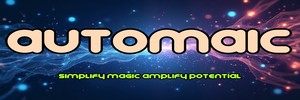Introduction
In the digital age, where every business strives to carve its niche online, understanding the technological backbone of successful platforms can offer invaluable insights. One such example is Automaic.com, a platform that has leveraged cutting-edge technology to deliver exceptional services. This exploration into the technology powering Automaic.com not only serves as an educational journey but also as a source of inspiration for aspiring tech entrepreneurs and developers. By dissecting the layers of technology that make Automaic.com a formidable player in its space, readers can glean lessons on scalability, user experience, and innovation. The importance of such an analysis cannot be overstated, as it provides a roadmap for implementing similar technologies in your projects or businesses, potentially transforming challenges into opportunities for growth and development.
This post aims to unravel the technological fabric of Automaic.com, exploring the various technologies employed, their integration, and the benefits they bring to the table. From cloud computing platforms that ensure scalability and flexibility, to the use of artificial intelligence for personalized user experiences, the technology stack of Automaic.com is a testament to the power of modern software engineering. Additionally, we will delve into the specific programming languages and frameworks that form the bedrock of the platform, shedding light on why certain choices were made and how they contribute to the platform's overall performance and reliability. Through this comprehensive analysis, readers will gain a deeper understanding of the technological intricacies behind successful online platforms, equipped with practical knowledge that can be applied to their ventures.
The Core Technology Stack
At the heart of Automaic.com's success lies its sophisticated technology stack, a combination of programming languages, frameworks, and tools that enable the platform to function seamlessly. The choice of a specific technology stack is crucial as it affects not just the development phase but also the scalability, security, and maintainability of the platform. For instance, Automaic.com relies heavily on languages like Python and JavaScript, renowned for their flexibility and community support. Python, with its simplicity and readability, powers the backend processes, handling data analysis, and server-side logic. JavaScript, on the other hand, brings the user interface to life, creating dynamic and interactive web pages that enhance user experience.
Furthermore, frameworks such as Django (Python) and React (JavaScript) are integral components of Automaic.com's technology stack. Django offers a high-level, MVT (Model-View-Template) architecture that simplifies the development of complex, database-driven websites. Its "batteries-included" approach provides out-of-the-box solutions for common development hurdles, thereby accelerating the development process. React's component-based architecture allows for the development of reusable UI components, fostering a more efficient and consistent frontend development workflow. By leveraging these technologies, Automaic.com ensures a robust, scalable, and secure platform that can handle large volumes of traffic and data with ease.
Cloud Computing and Scalability
The scalability of Automaic.com is underpinned by its strategic use of cloud computing services. Cloud platforms like AWS (Amazon Web Services), Google Cloud Platform, and Microsoft Azure offer a suite of scalable, on-demand resources that can be tailored to the specific needs of a business. Automaic.com, for example, utilizes AWS for its hosting needs, taking advantage of services such as EC2 for flexible compute capacity, S3 for scalable storage, and RDS for managed relational databases. This not only ensures that the platform can scale resources up or down based on traffic demands but also optimizes costs by paying only for the resources used.
Moreover, cloud computing platforms provide a plethora of tools and services that support DevOps practices, such as continuous integration and delivery (CI/CD), containerization, and orchestration. These practices are crucial for maintaining a fast-paced development cycle, ensuring that new features and updates can be deployed quickly and efficiently. By embracing a cloud-native approach, Automaic.com benefits from increased agility, resilience, and operational efficiency, allowing the platform to innovate and adapt to market changes rapidly.
Artificial Intelligence and Personalization
Artificial Intelligence (AI) plays a pivotal role in enhancing the user experience on Automaic.com, through personalization and intelligent features that anticipate user needs. Machine learning algorithms analyze user data to deliver personalized content, recommendations, and services, making the platform more intuitive and user-friendly. For instance, AI-driven chatbots offer real-time customer support, answering queries and providing assistance with a level of responsiveness that closely mimics human interaction.
Furthermore, AI and natural language processing (NLP) technologies enable features such as voice search and command functionalities, allowing users to interact with the platform in more natural and convenient ways. These intelligent features not only improve user engagement but also drive retention, as users are more likely to return to a platform that understands their preferences and provides a tailored experience. The integration of AI into Automaic.com showcases the platform's commitment to leveraging cutting-edge technology to meet and exceed user expectations.
Security Measures
In today's digital landscape, security is of paramount importance. Automaic.com employs a multi-layered security approach to protect user data and ensure platform integrity. This includes the use of HTTPS to encrypt data in transit, regular security audits to identify and mitigate vulnerabilities, and adherence to best practices in data storage and access. Additionally, features such as two-factor authentication (2FA) and role-based access control (RBAC) are implemented to enhance user account security and ensure that access to sensitive information is strictly controlled.
On the backend, Automaic.com uses secure coding practices to prevent common security threats such as SQL injection, cross-site scripting (XSS), and cross-site request forgery (CSRF). Regular updates and patches are applied to the platform's underlying technologies, frameworks, and dependencies to protect against newly discovered vulnerabilities. By prioritizing security at every level of the platform, Automaic.com builds trust with its users, fostering a safe and reliable online environment.
Conclusion
The technology powering Automaic.com is a harmonious blend of modern programming languages, frameworks, cloud computing, artificial intelligence, and robust security measures. This comprehensive technology stack not only facilitates a seamless and engaging user experience but also ensures scalability, performance, and reliability. By dissecting the various technological components that contribute to the platform's success, we can appreciate the meticulous planning and strategic decision-making involved in its development.
For aspiring tech entrepreneurs and developers, Automaic.com serves as a prime example of how leveraging the right technologies can create a powerful and impactful online platform. The lessons learned from Automaic.com's technological approach are manifold: the importance of choosing a flexible and scalable technology stack, the benefits of cloud computing in achieving operational efficiency, the role of artificial intelligence in personalizing user experiences, and the imperative of implementing comprehensive security measures. Armed with these insights, readers are better equipped to embark on their tech ventures, inspired by the technological prowess behind Automaic.com.









